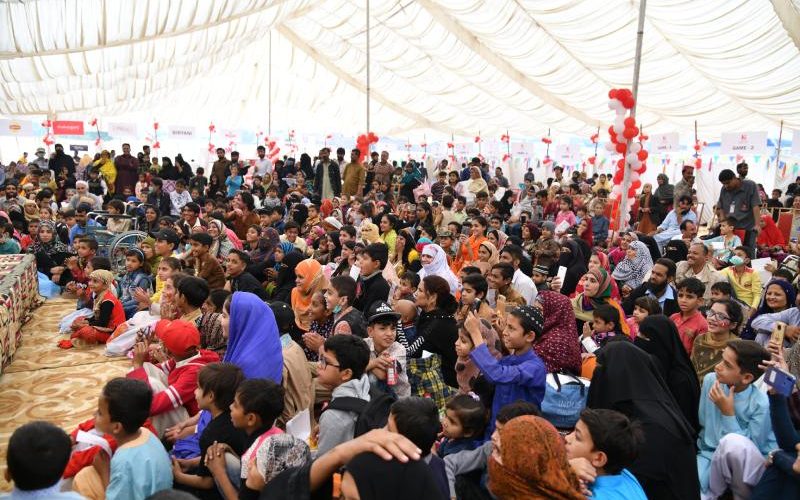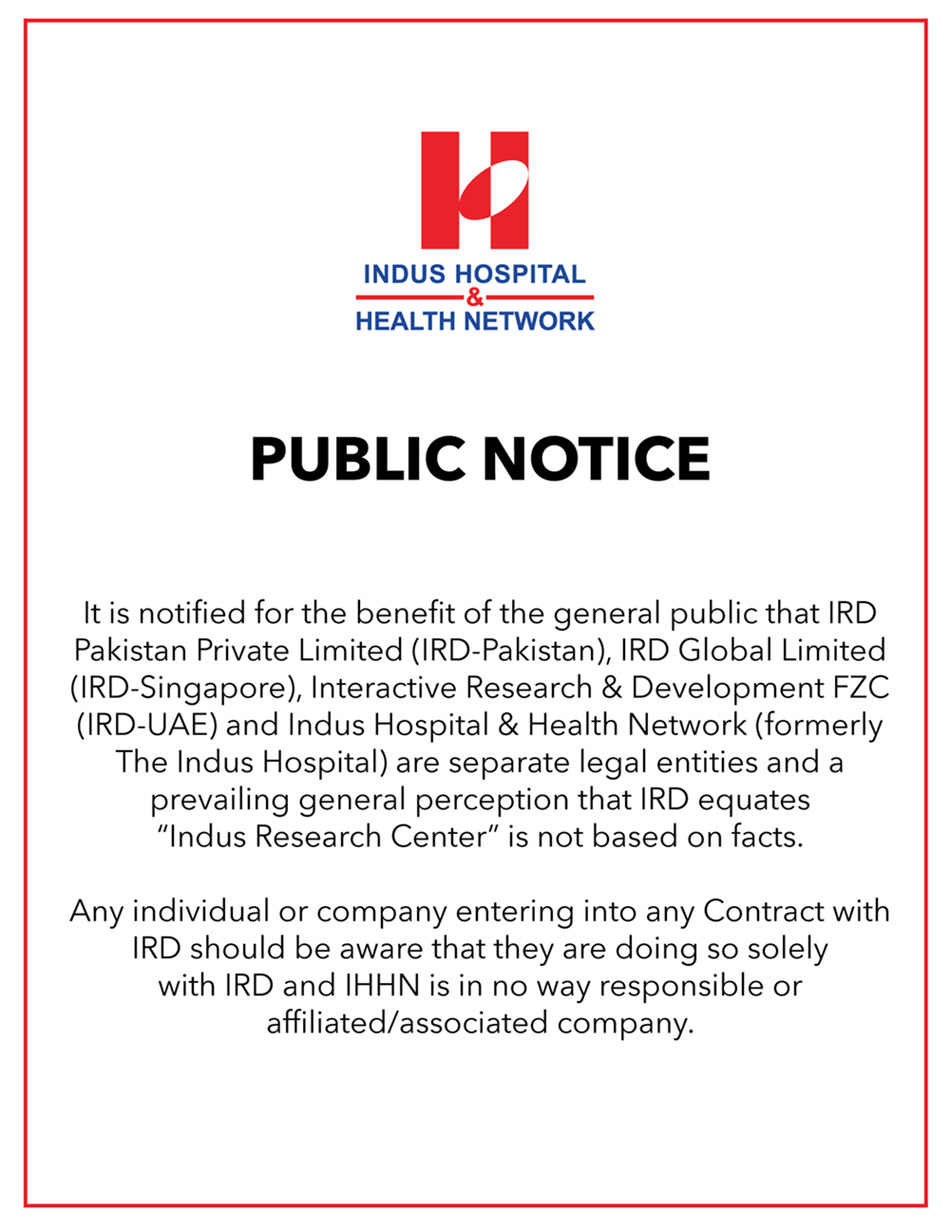THE INDUS HOSPITAL PROTECTS THE FUTURE OF PAKISTAN BY SAVING CHILDREN FROM DEADLY DISEASES
Saturday, December 14, 2019
Karachi, Pakistan
The Indus Hospital (TIH) offers a wide variety of comprehensive medical care for infants and children. Children need special care and TIH offers an inclusive treatment which not only curative but it also takes into account their behavioral, entertainment, and educational needs as well. The hospital offers child-friendly environment and celebrates their successful treatment. In accordance with the tradition, TIH, organized a Children’s Carnival on Saturday, December 14, 2019. The Universal Children’s Day is celebrated globally on December 15 to celebrate children and to highlight the charter of children’s rights around the world. The event was clubbed with another children-specific cause – Clubfoot. Clubfoot is a four-year treatment program to rectify clubfoot problem in children. Every year, TIH, organizes ‘Clubfoot Se Jeet Ka Jashan’ in order to celebrate the successful completion of treatment.
Dr. Abdul Bari Khan, Chief Executive Officer, Indus Health Network (IHN); Dr. Akhtar Aziz, Special Advisor to CEO, IHN; Mr. Abdul Hameed Paracha, Member Board of Directos (BoD), IHN; Mr. Yahya Chawla, Member BoD, IHN; Dr. Amin Chinoy, Executive Director, Physical Rehabilitation Directorate, IHN; Dr. Mansoor Khan, Chair, Surgery and Allied Services, TIH; Dr. Mohammad Fareedud Din; Head of Pediatric Medicine; TIH; Dr. Shahid Noor, Head of Orthopedic, Liaquat National Hospital and representatives of Aamer Haider Charitable Foundation, and other dignitaries attended the event.
Dr. Abdul Bari Khan, CEO Indus Health Network, said “this was our attempt at providing them with a unique opportunity to take a break from their medical concerns and procedures to just enjoy and for at least an afternoon, be just kids. It is truly a delight to see these families coming and enjoying themselves.”
The event was organized at the Korangi Campus and approximately 500 children and their family members attended it. The Psycho-Social and Physical Rehabilitation Departments co-hosted the event. It started with the recitation of the Holy Quran followed by the distribution of certificates among 130 Clubfoot patients.
Ms. Ayesha Haider of Aamer Haider Charitable Foundation told the audience what compelled her and her family to initiate this noble cause and how the foundation started this initiative with the Indus Hospital.
Renowned TV and Film actor, Ms. Sarwat Gillani who is the Indus Ambassador for children’s cause, shared her video message and congratulated pediatrics patients and their parents for the successful treatment and assured of her cooperation.
Dr. Amin addressed the audience and said, “over the past years, we felt that we are also a part of our patients’ families! We want to spread this message to motivate other affected children and their families. Pehla Qadam program envisages a Clubfoot-free Pakistan in future through the endeavors of its philanthropists and the dedication of its focused team. Through this event we want to acknowledge and appreciate the efforts of each child and their family in complying with the long course of treatment.”
Mother of a clubfoot patient also expressed her gratitude towards the Indus Hospital and especially the clubfoot team.
The Clubfoot celebrations were followed by the children carnival. The objectives to organize this activity was: to have a fun-filled activity day for pediatric patients; to engage different organizations/individuals to support these causes; to acknowledge and appreciate the efforts of each child and their family in complying with the long course of treatment; to raise awareness in order to motivate other affected children and their families.
Dr. Muhammad Fareeduddin talked about the objective of the Carnival and said, “these children go through so many ‘un-fun’ things on a regular basis. This carnival is an important psycho-social initiative in distracting them from their day-to-day pain and struggles with doctors, hospital visits, and needles. We want to help them build a positive association with the hospital.”
This year’s event included face painting, arts and crafts, lots of games and kiddie rides, and much more. Sponsors and supporters for this year’s celebration included Hamdard Laboratories, Espresso, Unilever Food Solutions, and many private donors.
To entertain children, some games/ rides and food stalls were set up. Children enthusiastically took part in all activities and won prizes. The sponsors also distributed goodie bags in children. Participants and their families were offered lunch boxes.
About The Indus Health Network (IHN)
In the year 2007, The Indus Hospital (TIH) started as a 150 bed, state-of-the-art, tertiary healthcare facility providing free yet quality treatment to every patient. After widening the scope of work, in 2017, the hospital transformed into the Indus Health Network (IHN). The network is focusing on the development and management of various public and private hospitals throughout Pakistan.
Pehla Qadam Program
In 2011, The Indus Hospital launched a service delivery program ‘Pehla Qadam’ in collaboration with Amer Haider Charitable Foundation, to treat children with clubfoot through the Ponseti method. The program’s mission is to eliminate untreated clubfoot in Pakistan by providing free treatment, along with capacity building at a national level. In eight years, PQ has established itself in Karachi as the treatment center, managing patients from all over Pakistan. In 2017, PQ expanded its services to Lahore, Muzaffargarh, and Badin. IHN spends approximately $250 on each patient.
Pediatric Services
TIH is a 300-bedded hospital out of which 115 beds are dedicated for pediatric services which include 85 beds for pediatric oncology patients. As of June 2018, about 9,000 children have been treated for cancer and blood diseases. The pediatric complex also houses a hospital-based school – Indus Ke Sitaray – to teach all pediatric patients.




